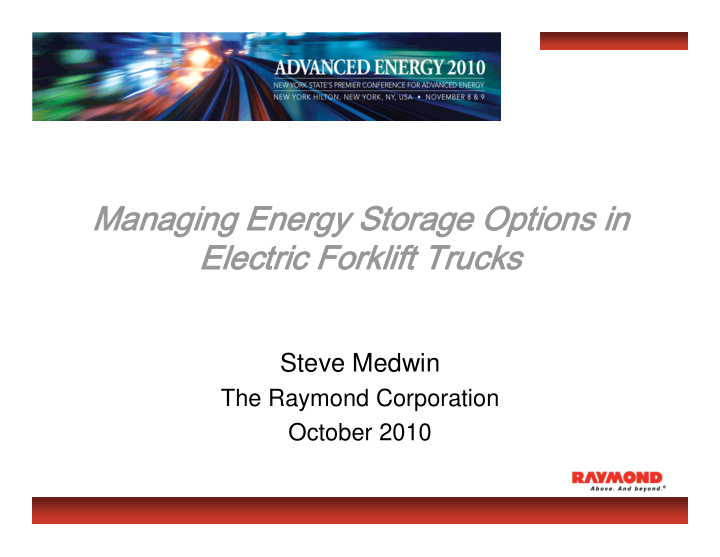



Managing Energy Storage Options in Electric Forklift Trucks Steve Medwin The Raymond Corporation October 2010
Agenda The Raymond Corporation Forklift Truck Challenge Energy Storage Issues & Options Five Critical Requirements Conclusion
The Raymond Corporation Founded in 1922 – Design, manufacture, sell & service electric forklift trucks Purchased by Toyota Industries in 2000 – Now part of Toyota Material Handling Group (TMHG) Started investigating fuel cells in 2004 Fuel cells operational in factory since 2007 Became independent distributor and service provider of Plug Power fuel cells in 2010 Also exploring other energy storage systems
Raymond Manufacturing Greene , NY VNA / Orderpicker Reach Trucks Counterbalance Custom Solutions Muscatine, IA Pallet Trucks Walkie Stackers
Eco-Performance AC Technology and Industry Leading Hydraulics – 20% more lifts per batter charge – 12% more pallets per hour Energy Regeneration – Regenerative Braking creates less wear and brake dust – Regenerative Lowering maximizes battery efficiency iWarehouse ™ Fleet Optimization – Monitors individual operator and truck performance Hydrogen Fuel Cells – Only byproduct – heat and water – No lead batteries or emissions Service and Maintenance – Preventative maintenance Sustainable Corporate Practices
Forklift Truck Challenge Forklift trucks designed for specific functions in a warehouse Energy storage requirements need to reflect the specific usage of a truck Electric forklift trucks have been designed around a lead- acid battery because that was the only viable device for storing energy Today there is a diversity of storage technologies available , from fuel cells to alternate batteries The challenge facing customers and manufacturers is which technology is best for a given application and what are the implications for the truck design and utilization .
Forklift Truck Usage Elevators Order Picker Truck Reach Truck % Vertical Transport Counterbalance Truck Pallet Grid Truck Automobiles Storage % Horizontal Transport
Issues to Consider Operational – Shifts per day – Cycle rate – Energy Storage System (ESS) capacity – Time to swap ESS, if needed – Compatibility with truck (ref. ITA ESS RP) Financial – Cost per unit – Impact on productivity – ESS life – Infrastructure cost (e.g. hydrogen supply) Environmental – Temperature – ambient or cold storage – Materials of construction & recyclability
Energy Storage Options Electrochemical – Lead acid battery – Nickel metal hydride battery – Lithium ion battery – Hydrogen fuel cell (PEM) – Direct methanol fuel cell Electrostatic – Super capacitor Mechanical – Hydraulic accumulator – Compressed air – Flywheel
Ragone Chart Showing Targets From: Lawrence Berkeley Lab – Battery Workshop
Energy Source and Design of Forklift Truck Lead-acid battery has always been critical part of design
Ensuring Compatibility Between ESS and Forklift Truck Industrial Truck Association (ITA) established Energy Storage System (ESS) committee to work on this issue – Includes fuel cells and new battery technologies Created Recommended Practice (RP) to facilitate the communication between truck manufacturers and ESS manufacturers RP describes the minimum requirements and key characteristics of the ESS as they relate to the lift truck originally designed for use with a lead acid battery
Five Critical Requirements for Energy Storage Systems 1. Size 2. Weight 3. Center of gravity 4. Power delivered 5. Power absorbed
1. Size “The maximum dimensions of the ESS are defined as the size of the battery designed to fit into a given truck as defined by the truck manufacture.” Fuel cell unit in pallet truck Fuel cell unit in reach truck
2. Weight “The weight of the ESS shall be within the minimum and maximum battery weight indicated on the industrial truck specification plate.” Typical truck specification plate
3. Center of Gravity “The location of the ESS center of gravity (CG) should be located within a cylindrical shape of radius r as defined by the truck manufacturer and shaded in the figure below, with the top of the cylinder located at the volumetric center (X,Y,Z) of the battery being replaced.”
4. Power Delivered “The truck manufacturer shall specify the current and voltage delivery requirements of the industrial truck at various time durations necessary to maintain acceptable performance.” V1max V2max V3max Voltage (volts) 0 Nominal voltage V3min and current must V2min be compatible V1min with existing truck I1 components Current (amps) I2 I3 0 T1 T2 T3 Time (seconds)
5. Power Absorbed “The truck manufacturer shall specify the current and voltage absorption requirements of the industrial truck at various time durations necessary to maintain acceptable performance.” V4max V5max Voltage (volts) 0 V5min Peaks and V4min valleys must not damage truck I4 components Current (amps) I5 0 T4 T5 Time (seconds)
Conclusion Need to match Energy Storage System to truck model and application Challenge is diversity at each customer location – Multiple truck models per site – Multiple applications per site – Multiple types of energy storage available Suppliers need to understand entire range of customer energy storage needs Truck manufacturers need to test variety of systems in their models Customers need to partner with a company that will commit to delivering the best solution to fit their individual needs
Steve Medwin steve.medwin@raymondcorp.com www.raymondcorp.com
Recommend
More recommend